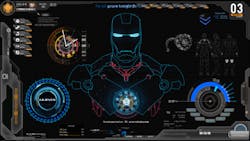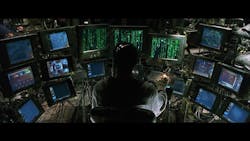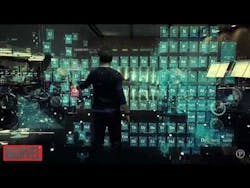The previous blog (http://tdworld.com/blog/life-energy-control-center-operator-ecco) explained what an ECCO does briefly, what’s unique about ECCOs and the stresses and importance of their job. I was asked to write about what ECCO does during non-emergency conditions. Prior to reading the responsibilities below, think of the ECCO as Jarvis in the movie Iron Man, the main control power/panel behind the suit and all Iron Man’s power or the operator from the movie “The Matrix”.
Before we discus different job responsibilities, please note that different utilities have different job titles and functions; however, I will try to generalize and include the functions that I am aware of:
· Emergency response: this has been discussed prior; simply assume you live in a city that is supplied by a substation that is supplied by two transmission towers. Now let’s assume, the station operator calls the energy control center and informs him/her that the tower or transformer on circuit 1 is on fire and immediate action is warranted. The ECCO has to assess the situation in no time and perform the necessary steps to de-energize (make unavailable) that troubled circuit only, such that he/she does not interrupt the electricity supply to the entire city. Trust me, it is much more difficult and challenging than this and of course, the complexity is proportional to the complexity of the utility’s electric grid and current system conditions just prior to receiving that emergency call.
· Schedule work: that may be broken into several classifications (for generation, transmission, substation and distribution):
o Schedule work after an emergency event, i.e., we may have restored the circuit or customers if there was an outage, yet the circuit needs to be restored to its 100% condition.
o Global change: may be related to emergency work or not, where a certain equipment defect was discovered that poses threat to the company personnel, public or the continuity of service and as a result all locations where this defect exist must be worked on, i.e. similar in cars recall.
o Reliability: schedule jobs to maintain the utility’s reliability standards and specifications, i.e. removing certain type of cable or part of equipment for reliability purposes.
o Load relief: as load grows, economy flourishes, more demand is added to the electric grid, and as a result, larger transformers, bigger size cables, new equipment, etc. are needed to sustain the demand increase.
o New business work: as small as one customer or more who either upgrading their service to a larger service, adding new equipment or the customer is entirely new altogether. Work is needed to connect the utility supplies to the customer’s equipment.
o Renewable energy: distributed generation, solar, wind and other renewable sources get added to the grid, work is needed to facilitate the interconnection, or to add stand-by services, in case the customer’s distributed generation or other sources are either inadequate to supply the full load or may be unavailable for any reason, i.e. schedule maintenance.
o Reacting to a sudden loss of wind in areas where wind energy is a large percentage of the utility’s generation.
· Customer request: certain customers may call the energy control centers and request to take their equipment out of service, i.e. testing their back-up generation or other customer related work or other work in the transit authority.
· Daily system responsibilities:
o React to alarms, i.e. investigate the cause and validity of the alarms and provide corrective actions.
o Control the station and transmission system voltages and ensure the voltage is within the schedule and specification. Think of the voltage as pressure and the danger of extremely high and extremely low voltage on the equipment and your household equipment.
o Facilitates all scheduled preventive maintenance.
o React to other non-forecasted events, i.e. car colliding with an electric pole that either resulted in damage to the pole and equipment or the fire department/police department or the city requesting that we remove from service the cables.
o Coordinate with generator operators when the units are either coming online or offline or when there is a need to adjust their loads.
o Work with engineering when an existing equipment or cable is approaching its capability or exceeded its capability.
o Prepare contingency plans for schedule outage, basically evaluate all the “what if scenarios” and providing corrective action for each scenario.
o Review impact of proposed schedule outage.
o Work with vendors/R&D and other departments when engineering or outside vendors want to test certain equipment or configuration.
o Facilitate testing new equipment, i.e. test set, breakers, etc.
o Monitor the system during storms, especially during lightning.
o React to whatever Mother Nature brings on, i.e. heavy rain, floods, hurricanes, lightning, sandy, extreme heat waves, etc.
o Interact with system operators, such as the NYISO, PJM, etc...
o Constantly reviewing the impact of losing the next worst cable/ equipment/ciruit and in some cases reviewing the next two worse cases.
o Reduce voltage at troubled areas when needed to reduce system stress and reduce loads.
o React to environmental events such as oil leaks.
o React to contractor’s damage, i.e. contractors digging into a live electric underground cable.
o React to water main break, which results in damage to electric cables and transformers.
o Review proposed system configuration changes from reliability and operations perspective.
o React to loss of communication, i.e. loss of telemetry (unable to view status of equipment, alarms and loading remotely from the control center) or loss of protection (this will probably be discussed in future blogs).
o Reacting to customer outages in an expedite manner.
o Reacting to gas leaks.
o Reacting to shortage of gas, especially if it will impact the generation of electricity.
o Providing control center tours for curious people to see where the magic takes place
o Responding to political requests and providing information to upper management mainly pertaining to unscheduled forced outages.
o Ensures that the utility’s system aides by federal and state policies and does not violate any procedures, i.e. FERC/NERC/NPCC, etc.
As seen, the ECCO has a lot of responsibilities (I didn’t even mention most of the responsibilities), none of which is marginal. In summary, ECCO is responsible for making sure electricity continues to be generated, transmitted and distributed in a safe and reliable manner; facilitates all system work to ensure the electric grid can withstand load growth and meet projected summer and winter peaks; provides means to adopt renewable energy sources, electric vehicles, etc. and other new initiatives. As the electric system becomes more complex, the ECCOs’ job becomes more challenging and complex. Not to mention all the work above occurs seamless to the customers. It is interting to visit a control center if you have the privileage and see how many monitors are in front of each operator.
About the Author
Ahmed Mousa
Principal Engineer/Adjunct Professor/Board Member/Founder & CEO
Ahmed Mousa, M.S.E.E., has over 12 years of experience in transmission, sub-transmission, substations and distribution systems with industry leaders such as Consolidated Edison, PSE&G, PEPCO, and First Energy. He is a subject matter expert in transmission/sub-transmission, distribution and substation planning. Ahmed has years of expertise conducting PSS/E load flows, i.e. forced & scheduled outages analysis, phase angle studies, voltage analysis, network/non-network load transfers. Ahmed provides analysis and support during heat waves, storms and other system emergencies.
Mr. Mousa is an Adjunct Professor at New Jersey Institute of Technology (NJIT) teaching advanced topics graduate electrical engineering courses.
Mr. Mousa serves on the New Jersey Association of Energy Engineers board as a board member.
Mr. Mousa is currently the Principal Engineer at PSE&G in the Electric Delivery Planning section, where he is responsible for managing power system generation, transmission and distribution simulation studies, developing the short/ long range substation forecasts, analysis and load relief, performing short circuit studies, performing breaker duty analysis, developing transmission and distribution station and feeder designs, reviewing large customer demand proposals. Mr. Mousa is responsible for all Distributed Energy Resources technical evaluations and interconnection agreements.
Mr. Mousa is the Founder/CEO of The Electric Bridge Consulting firm assisting large and small utilities, colleges/universities & consulting firms by providing electric utility services, educational/training services, consulting services, leadership seminars, career consulting, lecturing services, electric professional engineering courses & national & international webinars.
Mr. Mousa was responsible for the short term, long term (1/5/10/20/30 years), and emergency planning for the area substation, transmission / sub-transmission feeders and the 4 kV system at Consolidated Edison. He has conducted several studies on the impact of electric vehicles, distributed generation, steam to AC conversion, energy efficiency models, and R&D initiatives on the distribution and transmission system.
Mr. Mousa was the project manager for a SCADA GE XA21 Energy Management System and the project manager and project engineer for President Obama’s Department of Energy stimulus grant for Consolidated Edison’s 4 kV system.
Awards include the 2009 3rd Quarter Distribution Engineering ALVA Award for 21st Century Leader, the 2012 “Sustain Energy Reliability” Team Award, and the 2013 Excellence in Design and Genius Engineer (EDGE) Award Nominee for “Developed Load Calculation Tools for System and Transmission Operations.” He has over eight years of experience in providing training in a wide range of subjects including PSS/E, 4 kV systems, distributed generation grid adoption, system operation outage analysis, transformer ratings, voltage studies, basic and advanced power flow, intermeshes, phase angle studies, capacitor bank impact on the grid, smart grid, plant information (PI), post contingency analysis, voltage reduction, and conservation voltage optimization. Mr. Mousa received his Bachelor's Degree in Electrical Engineering from Stony Brook University and later a Master's Degree in Electrical Engineering from Manhattan College and has completed the Siemens PTI Distribution and Transmission courses.




